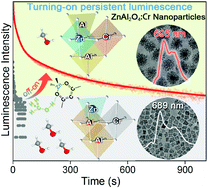Turning-on persistent luminescence out of chromium-doped zinc aluminate nanoparticles by instilling antisite defects under mild conditions†
Abstract
Spinel oxide nanocrystals are appealing hosts for Cr3+ for forming persistent luminescent nanomaterials due to their suitable fundamental bandgaps. Benefiting from their antisite defect-tolerant nature, zinc gallate doped with Cr3+ ions has become the most studied near-infrared (NIR) persistent luminescent material. However, it remains challenging to achieve persistent luminescence from its inexpensive analogs, e.g., zinc aluminate (ZnAl2O4). Because the radius difference of the cations in the latter system is bigger, it is intrinsically unfavorable for ZnAl2O4 to form Zn–Al antisite defects under mild conditions. Herein, we report a wet-chemical synthetic route for preparing Cr3+-doped ZnAl2O4 nanoparticles with long NIR persistent luminescence. It was demonstrated that methanol (MeOH) as an important component of the mixed solvent played a critical role in tailoring the morphology of the resulting ZnAl2O4:Cr nanocrystals. It could particularly drive the formation of antisite defects in the resulting coral-like nanoparticles bearing zinc-rich cores and zinc gradient peripheries. To disclose the effects of MeOH on the formation of antisite defects as well as particle morphologies, small molecules released during the pyrolysis of metal acetylacetonate precursors were analyzed by using gas chromatography-mass spectrometry. In combination with density functional theory (DFT) calculations, it was found that MeOH can effectively catalyze the thermolysis of metal acetylacetonate precursors, in particular Zn(acac)2. Therefore, MeOH exhibits remarkable effects on the formation of antisite defects by balancing the decomposition rates of Zn(acac)2 and Al(acac)3 through its volume fraction in the reaction system. This work thus constitutes a hitherto less common strategy for achieving NIR persistent luminescence from Cr3+-doped ZnAl2O4 nanoparticles by engineering the cation defects under mild conditions.



 Please wait while we load your content...
Please wait while we load your content...